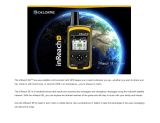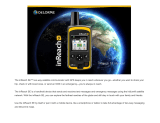
Table of Contents
Getting Started............................................................... 1
Device Overview......................................................................... 1
Turning the Device On or Off...................................................... 1
Acquiring GPS Signals............................................................... 1
Status Bar Icons......................................................................... 1
Using the On-Screen Buttons..................................................... 1
Adjusting the Volume.................................................................. 1
Using the Audio Mixer............................................................ 1
Adjusting the Screen Brightness................................................ 1
Transportation Modes................................................................. 1
Choosing a Transportation Mode.......................................... 2
Using the Large Button Keyboard.............................................. 2
Installation...................................................................... 2
Mounting Your Device in a Motorcycle....................................... 2
Powered Motorcycle Mount................................................... 2
Installing the Handlebar Base................................................ 2
Attaching the Power Cables to the Motorcycle Mount........... 2
Attaching the Base Plate to the Motorcycle Mount................ 2
Attaching the Base Plate to the Handlebar Base................... 3
Installing Your Device in the Motorcycle Mount..................... 3
Removing Your Device from the Motorcycle Mount................... 3
Mounting Your Device in an Automobile.................................... 3
Rider Awareness Features and Alerts.......................... 3
Enabling or Disabling Rider Alerts.............................................. 4
Red Light and Speed Cameras.................................................. 4
Incident Detection and Notifications........................................... 4
Setting Up an Incident Contact.............................................. 4
Cancelling an Incident Notification......................................... 4
Disabling Incident Notifications.............................................. 4
inReach Remote......................................................................... 4
Connecting an inReach Device............................................. 4
Sending an inReach Message............................................... 4
SOS....................................................................................... 5
Viewing Helmet Law Notifications...............................................5
Searching for Helmet Laws.........................................................5
Navigating to Your Destination..................................... 5
Routes........................................................................................ 5
Starting a Route.......................................................................... 5
Taking a Route Using Garmin Adventurous Routing™......... 5
Changing the Route Calculation Mode.................................. 5
Starting a Route by Using the Map........................................ 5
Going Home........................................................................... 6
Your Route on the Map...............................................................6
Active Lane Guidance............................................................ 6
Viewing Turns and Directions................................................ 6
Viewing the Entire Route on the Map.................................... 6
Arriving at Your Destination........................................................ 6
Parking Near Your Destination.............................................. 6
Changing Your Active Route...................................................... 6
Adding a Location to Your Route........................................... 6
Shaping Your Route...............................................................7
Taking a Detour..................................................................... 7
Stopping the Route..................................................................... 7
Avoiding Delays, Tolls, and Areas.............................................. 7
Avoiding Traffic Delays on Your Route.................................. 7
Avoiding Toll Roads............................................................... 7
Avoiding Toll Stickers.............................................................7
Avoiding Road Features........................................................ 7
Custom Avoidances............................................................... 7
Navigating Off Road................................................................... 8
Fuel Tracking.............................................................................. 8
Enabling Fuel Tracking.......................................................... 8
Setting a Low Fuel Warning................................................... 8
Resetting the Fuel Tank Mileage
........................................... 8
Enabling Dynamic Fuel Stops................................................ 8
Finding and Saving Locations...................................... 8
Finding a Location Using the Search Bar................................... 8
Points of Interest......................................................................... 8
Finding a Location by Category.................................................. 8
Navigating to Points of Interest Within a Venue.................... 9
Viewing Your Garmin Explore™ Points of Interest..................... 9
Synchronizing Garmin Explore Account Data........................ 9
Location Search Results............................................................. 9
Location Search Results on the Map..................................... 9
Changing the Search Area......................................................... 9
Parking........................................................................................9
Finding Parking Near Your Current Location......................... 9
Finding Parking Near a Specified Location.......................... 10
Understanding Parking Colors and Symbols....................... 10
Search Tools.............................................................................10
Finding an Address.............................................................. 10
Finding an Intersection.........................................................10
Finding a Location Using Coordinates................................. 10
Finding HISTORY® Points of Interest...................................... 10
Foursquare............................................................................... 10
Connecting to Your Foursquare Account............................. 10
Searching Foursquare Points of Interest............................. 10
Viewing Foursquare Location Details.................................. 10
Checking in with Foursquare............................................... 10
TripAdvisor®............................................................................. 10
Finding TripAdvisor Points of Interest.................................. 10
Viewing Recently Found Locations.......................................... 10
Clearing the List of Recently Found Locations.................... 10
Viewing Current Location Information...................................... 11
Finding Emergency Services and Fuel................................ 11
Getting Directions to Your Current Location........................ 11
Adding a Shortcut..................................................................... 11
Removing a Shortcut........................................................... 11
Saving Locations...................................................................... 11
Saving a Location................................................................ 11
Saving Your Current Location.............................................. 11
Editing a Saved Location..................................................... 11
Assigning Categories to a Saved Location.......................... 11
Deleting a Saved Location................................................... 11
Using the Map............................................................... 11
Map Tools................................................................................. 11
Viewing a Map Tool............................................................. 12
Up Ahead.................................................................................. 12
Viewing Upcoming Locations............................................... 12
Customizing the Up Ahead Categories................................ 12
Cities Ahead............................................................................. 12
Viewing Upcoming Cities and Exit Services........................ 12
Trip Information.........................................................................12
Viewing Trip Data from the Map.......................................... 12
Viewing the Trip Information Page....................................... 12
Resetting Trip Information....................................................12
Viewing Upcoming Traffic......................................................... 12
Viewing Traffic on the Map.................................................. 12
Searching for Traffic Incidents............................................. 12
Customizing the Map................................................................ 13
Customizing the Map Layers............................................... 13
Changing the Map Data Field.............................................. 13
Changing the Map Perspective............................................ 13
Live Services, Traffic, and Smartphone Features..... 13
Bluetooth Feature Status Icons................................................ 13
Pairing Your Phone and Headset............................................. 13
Smart Notifications....................................................................13
Receiving Notifications.........................................................13
Table of Contents i























